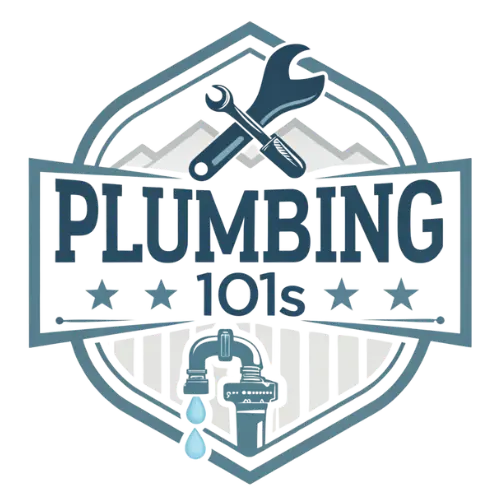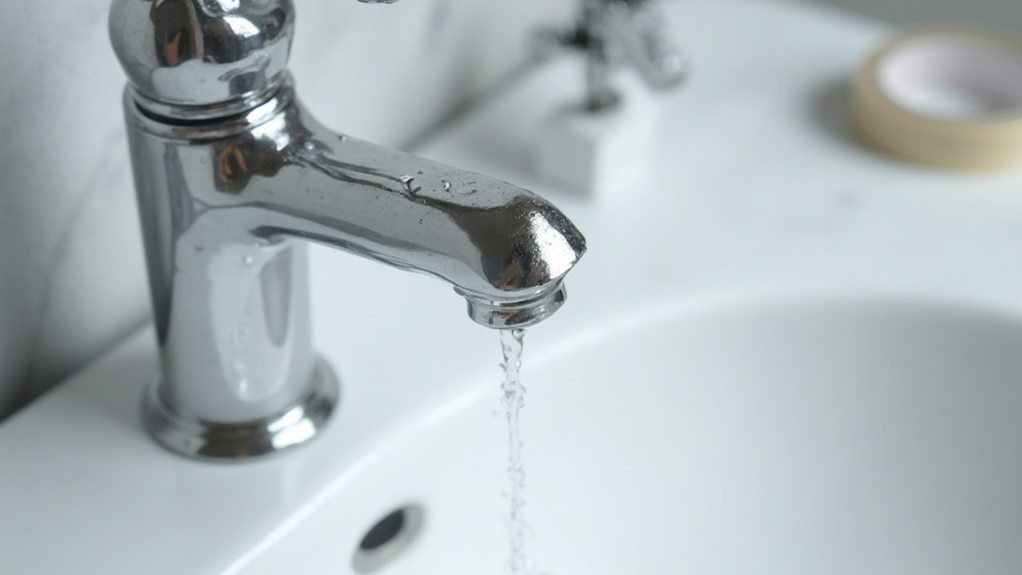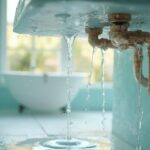Common plumbing leaks can be temporarily addressed using essential tools and proven methods. For small pipe leaks, apply pipe clamps with rubber gaskets for immediate containment, while epoxy putty effectively seals various pipe materials. Plumber's tape creates watertight seals on threaded connections, and self-fusing silicone tape works well for low-pressure lines. For faucet drips, which can waste up to 3,000 gallons annually, inspect and replace worn washers or O-rings. While these solutions provide temporary relief, persistent leaks require professional assessment to prevent water damage and costly repairs. Understanding the complete approach to plumbing maintenance can save substantial time and money.
Highlights
- Apply pipe clamps with rubber gaskets around small leaks to provide immediate containment until professional repairs can be made.
- Use plumber's tape (Teflon tape) on threaded connections to create watertight seals and prevent drips from faucets or showerheads.
- Seal visible cracks or holes in pipes with epoxy putty, which works effectively on both metal and plastic surfaces.
- Wrap self-fusing silicone tape around leaking low-pressure pipes to create a temporary waterproof barrier.
- Install pipe sleeves around weakened PVC pipe sections to reinforce and prevent further leakage while awaiting permanent repairs.
Essential Tools and Materials Needed
Four essential tools and materials form the foundation of any plumbing leak repair project. A sturdy pipe wrench, which allows for maximum grip on rounded surfaces, works alongside basic plumbing tools like pliers and a utility knife to provide complete control during repairs.
These implements enable precise adjustments and clean cuts when working with various pipe materials. For achieving a watertight seal on threaded connections, plumber's tape (also called Teflon tape) serves as a critical component that prevents minor leaks at pipe joints.
When dealing with emergency situations, epoxy putty offers reliable temporary repairs by creating a strong bond on both metal and plastic surfaces.
Essential Equipment Checklist:
- Pipe wrench and pliers for secure gripping
- Utility knife for precise cutting
- Plumber's tape for thread sealing
- Epoxy putty for emergency patches
- Pipe clamps with rubber gaskets
- Bucket or wet vacuum
To minimize water damage during repairs, keeping a bucket or wet vacuum nearby helps maintain a dry work area. Pipe clamps provide quick solutions for small leaks, featuring rubber gaskets that create immediate watertight seals without requiring extensive technical knowledge or specialized equipment.
Identifying Different Types of Leaks
Armed with the right tools, plumbers and homeowners must understand how to recognize various types of plumbing leaks for effective repairs. Water leaks can manifest in different ways, and identifying them early helps prevent further damage while minimizing water waste.
- Faucet leaks typically present as persistent drips or moisture around the base, wasting up to 3,000 gallons annually and requiring immediate attention to prevent escalating water bills.
- Toilet leaks often go undetected but can be identified through unusual sounds, water movement in the bowl, or by adding food coloring to the tank to check for seepage.
- Showerhead leaks frequently stem from faulty valves or worn washers, showing signs through constant dripping or water accumulation on surrounding surfaces.
When inspecting for pipe leaks, homeowners should check under sinks, around fixtures, and outdoor plumbing connections regularly. Leaky pipes may show signs through water stains, dampness, or unexplained increases in water bills.
While a temporary fix might work for minor issues, professional assessment is recommended for persistent plumbing leaks, especially when dealing with complex pipe systems or when multiple leaks are present.
Temporary Sealing Solutions
When faced with a sudden pipe leak, several reliable temporary sealing methods can provide immediate relief until professional repairs are possible.
Pipe clamps with rubber gaskets offer a quick solution for small leaks, while epoxy putty, which combines two compounds to create a hardened seal, works effectively on various pipe materials.
Self-fusing silicone tape, which creates a waterproof barrier when stretched and wrapped around the leak point, serves as another practical emergency solution, particularly for low-pressure water lines.
Emergency Pipe Patch Methods
During plumbing emergencies, several temporary sealing solutions can effectively contain leaks until permanent repairs are possible. From epoxy putty to pipe clamps, these methods provide quick fixes for water leaks in various pipe materials, including PVC, copper, and galvanized steel.
Key temporary repair solutions include:
- Epoxy putty application: Knead the two-part compound and press firmly over the leak, allowing it to harden at room temperature.
- Self-fusing silicone tape installation: Wrap tightly around the leaking area with 50% overlap between layers to create a waterproof seal.
- Pipe clamp placement: Position rubber gasket over the leak point and tighten the clamp for immediate pressure reduction.
For threaded connections experiencing leaks, plumbers tape offers an effective solution when properly applied to pipe threads. Simply unscrew the coupling, wrap the tape clockwise around the threads, and reassemble the connection.
In cases involving PVC pipes, pipe sleeves can reinforce weakened sections or cover small breaks, though adequate clearance around the pipe is necessary for proper installation.
These temporary fixes should provide sufficient time to arrange for professional plumbing services while preventing water damage to surrounding areas.
Sealing Small Water Leaks
Common Temporary Sealing Methods:
- Pipe clamps with rubber gaskets provide quick containment for small leaks, particularly in straight pipe sections where water is seeping through tiny cracks.
- Epoxy putty, a two-part compound that hardens at room temperature, can be applied directly to the leak point on various pipe materials.
- Plumbers tape, when properly wrapped around threaded connections in water supply lines, creates an enhanced seal to stop seepage.
- Self-fusing silicone tape requires tight application around the leak area, forming a waterproof barrier suitable for low-pressure situations.
Important Considerations:
- All temporary fix methods should be monitored regularly.
- Pipe sleeves offer reinforcement for weakened PVC sections.
- Water pressure may need reduction while temporary repairs are in place.
- Document leak location and type for professional repair planning.
- Replace temporary solutions with permanent repairs as soon as feasible.
Professional Vs DIY Repairs
For homeowners facing plumbing leaks, choosing between professional repairs and DIY solutions requires careful evaluation of both cost and risk factors. While DIY repairs might seem cost-effective for small leaks, temporary fixes can lead to significant damage and higher repair costs if not executed properly.
Key factors to take into account when deciding between professional and DIY repairs:
- Professional plumbers identify underlying issues and guarantee permanent repair solutions, whereas DIY attempts may overlook vital plumbing components.
- Emergency plumbing costs can exceed $850, making proper initial repairs essential for preventing costly urgent service calls.
- Licensed professionals guarantee compliance with building codes and maintain water supply system integrity.
When dealing with a leaky pipe, homeowners should evaluate the scope of the problem. Small leaks in accessible areas might be suitable for DIY repairs, but complex issues require professional intervention.
A professional plumber brings expertise that goes beyond surface-level fixes, often detecting potential problems before they escalate. While the initial cost of professional services ($150-$850) may seem high, it typically proves more economical than recurring DIY attempts that fail to address root causes.
Preventive Maintenance Tips
Five essential preventive maintenance practices can greatly reduce the likelihood of costly plumbing emergencies and extend system longevity. Regular inspection of fixtures and connections allows homeowners to identify minor issues before they develop into major problems, greatly reducing repair costs over time.
Key Preventive Actions:
- Install a water pressure regulator to maintain pressure below 80 PSI, preventing pipe stress and potential bursts.
- Apply pipe insulation in vulnerable areas to protect against frozen pipes during cold weather.
- Schedule professional plumbing inspections annually to detect corrosion and potential leaks early.
- Consider installing a water softener to prevent mineral buildup that can damage pipes.
Best Practices for Implementation:
- Document inspection dates and findings to track system performance.
- Test water pressure quarterly using a simple pressure gauge.
- Examine visible pipes monthly for signs of corrosion or moisture.
- Check pipe insulation before winter to guarantee proper coverage.
- Monitor water quality regularly to determine if a water softener is necessary.
Following these preventive maintenance guidelines can help avoid emergency repairs that typically cost between $150 and $850.
When to Replace Pipes
While preventive maintenance can extend the life of your plumbing system, recognizing when to replace pipes remains a critical aspect of home maintenance. Identifying the right time to replace old pipes can prevent costly water damage and protect your water supply from contamination.
Key indicators that signal the need for pipe replacement include:
- Visible corrosion on exposed pipes, particularly in homes with galvanized steel or lead plumbing systems over 50 years old
- Frequent repairs in the same damaged section, indicating systemic deterioration rather than isolated issues
- Persistent drops in water pressure or recurring plumbing leaks that suggest widespread pipe degradation
When evaluating leaky pipes, consider the long-term cost benefits of replacement versus repeated repairs.
While replacing pipes typically costs between $370 and $2,108, this investment often proves more economical than addressing frequent repairs.
Additionally, older plumbing systems, especially those containing lead components, can pose significant health risks through water contamination.
Professional plumbers can assess your system's condition and determine whether localized repairs will suffice or if complete replacement is necessary to guarantee safe, reliable water delivery throughout your home.
Frequently Asked Questions
How Do You Fix a Leaky Pipe Fast?
For emergency repairs of a leaky pipe, first shut off the water supply to prevent water damage.
Apply DIY solutions like epoxy sealant or plumber's tape for immediate pipe repair after leak detection.
Use basic plumbing tools like a pipe clamp with rubber gaskets for a temporary fix.
For loose connections, tighten coupling nuts with a wrench.
These home maintenance techniques provide quick solutions while awaiting professional repairs, minimizing potential structural damage.
How Do You Temporarily Stop a Plumbing Leak?
To temporarily stop a plumbing leak, first locate the emergency shut off valve and stop water flow.
For immediate containment, use a bucket catch while applying solutions.
Apply a rubber patch secured with a pipe clamp for small breaks, or wrap waterproof tape tightly around the affected area.
Silicone sealant or specialized hose repair products work well for minor leaks.
After leak detection, use duct tape as a last resort during a plumbing emergency.
What Do Plumbers Use to Stop Leaks?
Professional plumbers employ various specialized tools and materials for leak detection and repair.
They frequently use plumbing tape (Teflon) for joint repair, epoxy putty for creating watertight seals, and hose clamps with rubber gaskets for emergency patches.
Different sealant types, including self-fusing silicone tape, are selected based on water pressure requirements.
For thorough pipe sealing solutions, plumbers may utilize pipe repair casts, combining reinforced wraps with specialized compounds.
How Do You Stop Leaks Fast?
To stop leaks quickly, first locate the main water shutoff valve and turn it off immediately for emergency repairs.
Apply appropriate sealant types like epoxy putty or silicone tape for temporary DIY solutions.
For pipe insulation and faucet maintenance, use plumbing tools to tighten connections and replace worn washers.
Consider water pressure adjustments to prevent future leaks.
Professional leak detection methods may be necessary for complex issues requiring specialized drain cleaning or extensive repairs.
Final Thoughts
Conclusion:
Effective plumbing maintenance requires proper tools, accurate leak identification, and timely intervention using appropriate repair methods. While temporary fixes can address immediate concerns, long-term solutions often demand professional expertise. Regular inspections, coupled with preventive measures, help avoid costly repairs and water damage. Understanding when to attempt DIY repairs versus calling professionals guarantees peak plumbing system performance and extends the lifespan of pipes and fixtures.



